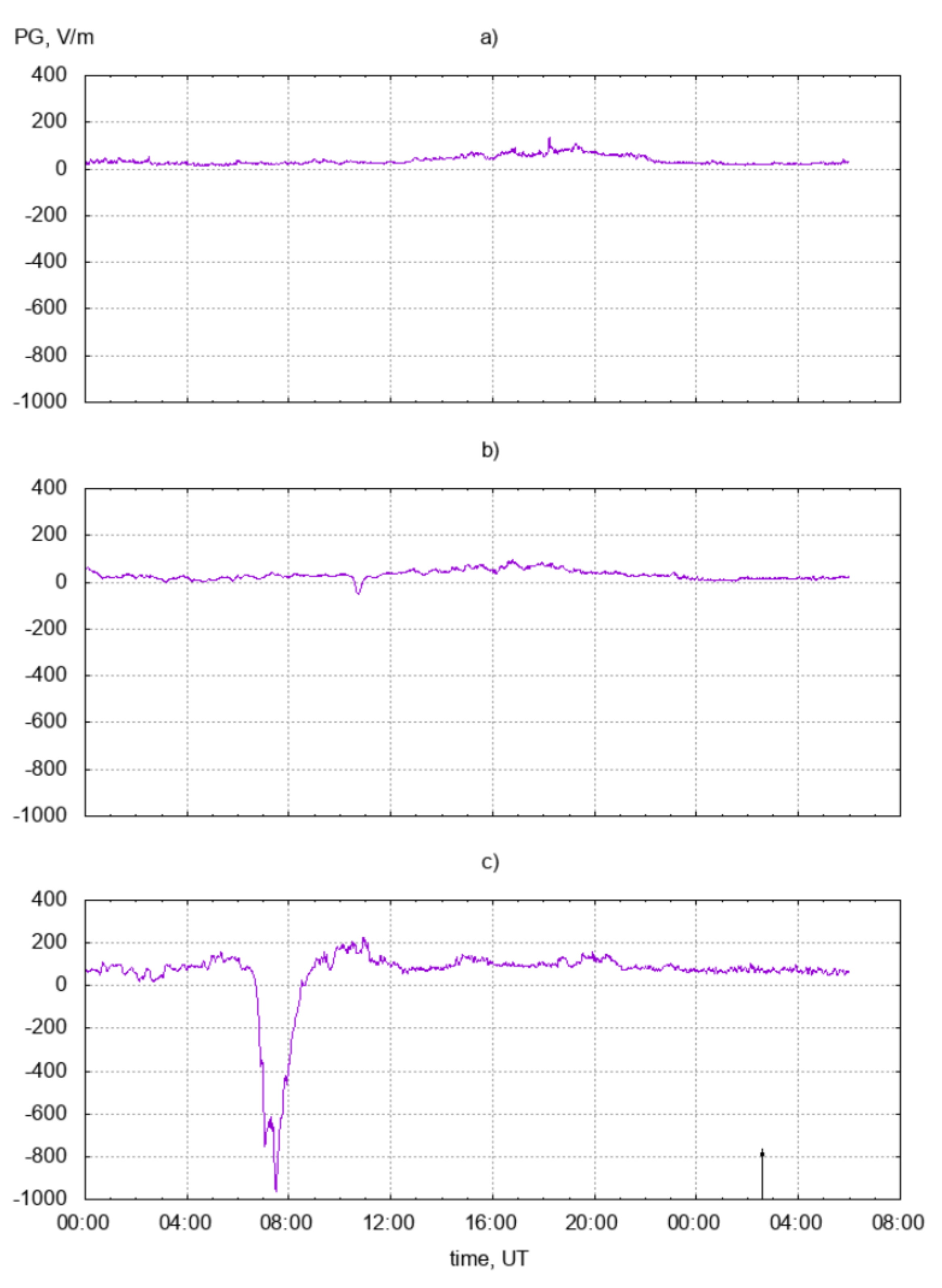Negative Anomalies of the Earth’s Electric Field as Earthquake Precursors
Abstract
:1. Introduction
2. Measurement Methods
3. Main Results and Discussion
- The occurrence of an anomalously high sporadic layer E (Es) that exceeded the background values of effective heights (h’Es) during calm geophysical conditions for a concrete time of day of at least 10 km within 1–3 h;
- An increase in Es frequencies of at least 20%, accompanied by an increase of the same duration within h of the time of the anomalously high Es occurrence.
4. Conclusions
- On small scales of time (T, hours) and distance, the bay duration and magnitude of the atmospheric potential gradient decrease was observed to depend on neither the earthquake class nor the distance to its epicenter;
- On large scales of time (T, days) and distance (R), the precursor depended on the earthquake magnitude (M), according to the formula
- The efficiency of the forecast method for any weather condition was 10%.
Funding
Acknowledgments
Conflicts of Interest
Abbreviations
| PG | potential gradient |
| EQ | earthquake |
References
- Kondo, G. The variation of the atmospheric electric field at the time of earthquake. Kakioka Magnet. Observ. Mem. 1968, 13, 11–23. [Google Scholar]
- Kachakhidze, N.; Kachakhidze, M.; Kereselidze, Z.; Ramishvili, G. Specific variations of the atmospheric electric field potential gradient as a possible precursor of Caucasus earthquakes. Nat. Hazards Earth Syst. Sci. 2009, 9, 1221–1226. [Google Scholar] [CrossRef]
- Hao, J.G.; Tang, T.M.; Li, D.R. A kind of information on short-term and imminent earthquake precursors: - Research on atmospheric electric field anomalies before earthquakes. Acta Seismol. Sin. 1998, 11, 121–131. [Google Scholar] [CrossRef]
- Hao, J.; Tang, T.; Li, D. Progress in the research of atmospheric electric field anomaly as an index for short-impending prediction of earthquakes. J. Earthq. Pred. Res. 2000, 8, 241–255. [Google Scholar]
- Choudhury, A.; Guha, A.; De, B.K.; Roy, R. A statistical study on precursory effects of earthquakes observed through the atmospheric vertical electric field in northeast India. Ann. Geophys. 2013, 56, R0331. [Google Scholar]
- Harrison, R.G.; Aplin, K.L.; Rycroft, M.J. Atmospheric electricity coupling between earthquake regions and the ionosphere. J. Atmos. Sol. Terrest. Phys. 2010, 72, 376–381. [Google Scholar] [CrossRef] [Green Version]
- Liperovsky, V.A.; Pokhotelov, O.A.; Meister, C.V.; Liperovskaya, E.V. Physical models of coupling in the lithosphere–atmosphere–ionosphere system before earthquakes. Geomagnet. Aeron. 2008, 48, 795–806. [Google Scholar] [CrossRef]
- Pulinets, S.A.; Alekseev, V.A.; Legen’ka, A.D.; Khegai, V.V. Radon and metallic aerosols emanation before strong earthquakes and their role in atmosphere and ionosphere modification. Adv. Space Res. 1997, 20, 2173–2176. [Google Scholar] [CrossRef]
- Freund, F.T.; Kulahci, I.G.; Cyr, G.; Ling, J.; Winnick, M.; Tregloan-Reed, J.; Freund, M. Air ionization at rock surfaces and pre-earthquake signals. J. Atmos. Solar Terrest. Phys. 2009, 71, 1824–1834. [Google Scholar] [CrossRef]
- Pierce, E.T. Atmospheric electricity and earthquake prediction. J. Geophys. Lett. 1976, 3, 185–188. [Google Scholar] [CrossRef]
- Pulinets, S.A.; Boyarchuk, K.A. Ionospheric Precursors of Earthquakes; Springer: Berlin, Germany, 2004. [Google Scholar]
- Hoppel, W.A. Theory of electrode effect. J. Atmos. Terr. Phys. 1967, 29, 709–721. [Google Scholar] [CrossRef]
- Mikhailov, Y.M.; Mikhailova, G.A.; Kapustina, O.V.; Depueva, A.X.; Buzevich, A.V.; Druzhin, G.I.; Smirnov, S.E.; Firstov, P.P. Variations in different atmospheric and ionospheric parameters in the earthquake preparation periods on Kamchatka: Preliminary results. Geomagnet. Aeron. 2002, 42, 769–776. [Google Scholar]
- Pulinets, S.A.; Legen’ka, A.D.; Zelenova, T.I. Local time dependence of seismoionospheric variations in the F-layer Maimum. Geomagnet. Aeron. 1998, 38, 178–183. [Google Scholar]
- Pulinets, S.; Ouzounov, D. Lithosphere–atmosphere–ionosphere coupling (LAIC) model—An unified concept for earthquake precursors validation. J. Asian Earth Sci. 2011, 41, 371–382. [Google Scholar] [CrossRef]
- Pulinets, S. Low latitude atmosphere–ionosphere effects initiated by strong earthquakes preparation process. Int. J. Geophys. 2012, 2012, 131842. [Google Scholar] [CrossRef] [Green Version]
- Khomutov, S.; Smirnov, S.; Butin, S.; Babakhanov, I. First results of atmospheric electricity measurements by CS110 electric field meter at Paratunka observatory, Kamchatka. E3S Web Conf. 2016, 11, 00008. [Google Scholar] [CrossRef] [Green Version]
- Mikhailov, Y.M.; Mikhailova, G.A.; Kapustina, O.V.; Buzevich, A.V.; Smirnov, S.E. Specific features of atmospheric noise superimposed on variations in the quasistatic electric field in the Kamchatka near-earth atmosphere. Geomagnet. Aeron. 2005, 45, 649–664. [Google Scholar]
- Smirnov, S. Association of the negative anomalies of the quasistatic electric field in atmosphere with Kamchatka seismicity. Nat. Hazards Earth Syst. Sci. 2008, 8, 745–749. [Google Scholar] [CrossRef]
- Pustovalov, K.N.; Nagorskiy, P.M. Response in the surface atmospheric electric field to the passage of isolated air mass cumulonimbus clouds. J. Atmos. Solar Terrest. Phys. 2018, 172, 33–39. [Google Scholar] [CrossRef]
- Smirnov, S. Reaction of electric and meteorological states of the near-ground atmosphere during a geomagnetic storm on 5 April 2010. Earth Planet. Space 2014, 66, 154. [Google Scholar] [CrossRef] [Green Version]
- Sidorin, A.Y. Dependence of the Occurrence Time of Earthquake Precursors on the Epicentral Distance. Dokl. Akad. Nauk SSSR 1979, 245, 825–828. [Google Scholar]
- Korsunova, L.P.; Khegai, V.V.; Mikhailov, Y.M.; Smirnov, S.E. Regularities in the manifestation of earthquake precursors in the ionosphere and near-surface atmospheric electric fields in Kamchatka. Geomagnet. Aeron. 2013, 53, 227–233. [Google Scholar] [CrossRef]


© 2019 by the author. Licensee MDPI, Basel, Switzerland. This article is an open access article distributed under the terms and conditions of the Creative Commons Attribution (CC BY) license (http://creativecommons.org/licenses/by/4.0/).
Share and Cite
Smirnov, S. Negative Anomalies of the Earth’s Electric Field as Earthquake Precursors. Geosciences 2020, 10, 10. https://doi.org/10.3390/geosciences10010010
Smirnov S. Negative Anomalies of the Earth’s Electric Field as Earthquake Precursors. Geosciences. 2020; 10(1):10. https://doi.org/10.3390/geosciences10010010
Chicago/Turabian StyleSmirnov, Sergey. 2020. "Negative Anomalies of the Earth’s Electric Field as Earthquake Precursors" Geosciences 10, no. 1: 10. https://doi.org/10.3390/geosciences10010010
APA StyleSmirnov, S. (2020). Negative Anomalies of the Earth’s Electric Field as Earthquake Precursors. Geosciences, 10(1), 10. https://doi.org/10.3390/geosciences10010010




